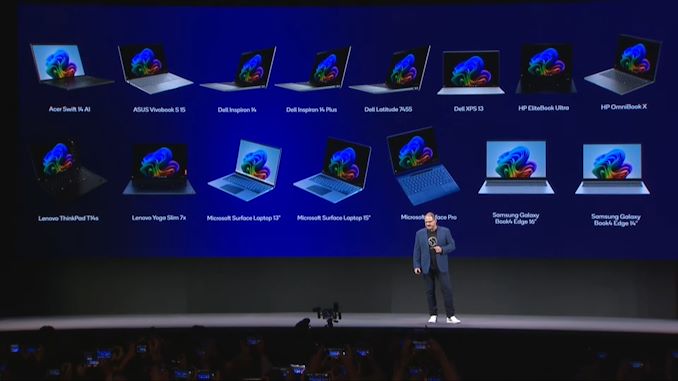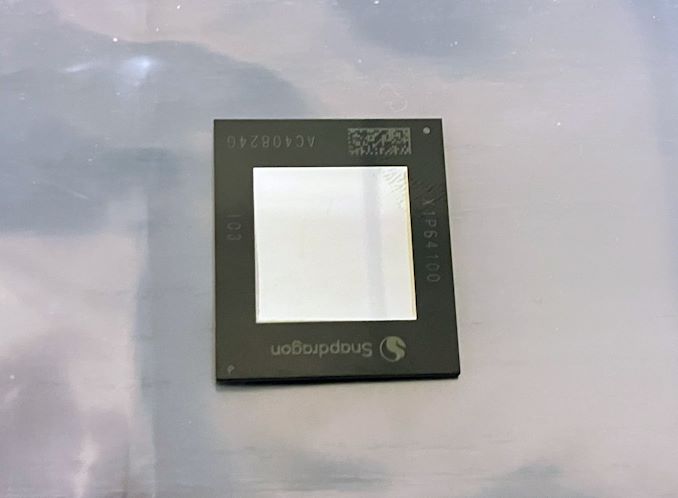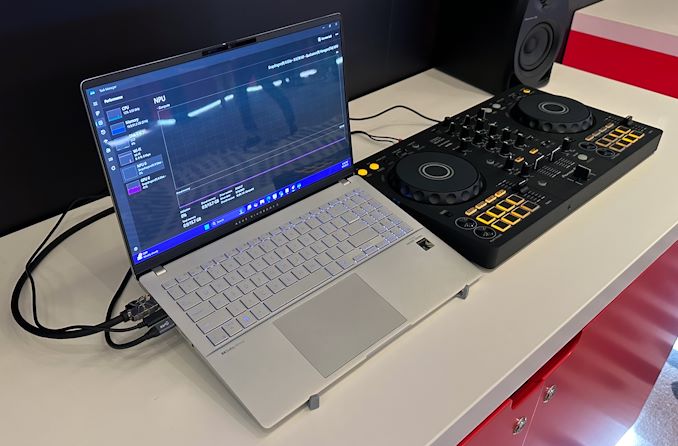The Qualcomm Snapdragon X Architecture Deep Dive: Getting To Know Oryon and Adreno X1
by Ryan Smith on June 13, 2024 9:00 AM EST
The curtains are drawn and it’s almost showtime for Qualcomm and its Snapdragon X SoC team. After first detailing the SoC nearly 8 months ago at the company’s most recent Snapdragon Summit, and making numerous performance disclosures in the intervening months, the Snapdragon X Elite and Snapdragon X Plus launch is nearly upon us. The chips have already shipped to Qualcomm’s laptop partners, and the first laptops are set to ship next week.
In the last 8 months Qualcomm has made a lot of interesting claims for their high-performance Windows-on-Arm SoC – many of which will be put to the test in the coming weeks. But beyond all the performance claims and bluster amidst what is shaping up to be a highly competitive environment for PC CPUs, there’s an even more fundamental question about the Snapdragon X that we’ve been dying to get to: how does it work?
Ahead of next week’s launch, then, we’re finally getting the answer to that, as today Qualcomm is releasing their long-awaited architectural disclosure on the Snapdragon X SoC. This includes not only their new, custom Arm v8 “Oryon” CPU core, but also technical disclosures on their Adreno GPU, and the Hexagon NPU that backs their heavily-promoted AI capabilities. The company has made it clear in the past that the Snapdragon X is a serious, top-priority effort for the company – that they’re not just slapping together a Windows SoC from their existing IP blocks and calling it a day – so there’s a great deal of novel technology within the SoC.
And while we’re excited to look at it all, we’ll also be the first to admit that we’re the most excited to finally get to take a deep dive on Oryon, Qualcomm’s custom-built Arm CPU cores. The first new high-performance CPU design created from scratch in the last several years, the significance of Oryon cannot be overstated. Besides providing the basis of a new generation of Windows-on-Arm SoCs that Qualcomm hopes will vault them into contention in the Windows PC marketplace, Oryon will also be the basis of Qualcomm’s traditional Snapdragon mobile handset and tablet SoCs going forward.
So a great deal of the company’s hardware over the next few years is riding on this CPU architecture – and if all goes according to plan, there will be many more generations of Oryon to follow. One way or another, it’s going to set Qualcomm apart from its competitors in both the PC and mobile spaces, as it means Qualcomm is moving on from Arm’s reference designs, which by their very nature are accessible Qualcomm’s competition as well.
So without further ado, let’s dive in to Qualcomm’s Snapdragon X SoC architecture.
Setting The Stage: Elite, Plus, & Currently Announced SKUs
As a quick refresher, Qualcomm has announced 4 Snapdragon X SKUs thus far, all of which have been made available to device manufacturers for next week’s launch.
| Qualcomm Snapdragon X (Gen 1) Processors | |||||||
| AnandTech | CPU Cores | All Core Max Turbo | Two Core Max Turbo | GPU TFLOPS | NPU TOPS | Total Cache (MB) |
Memory |
| Snapdragon X Elite | |||||||
| X1E-84-100 | 12 | 3.8 GHz | 4.2 GHz | 4.6 | 45 | 42 | LPDDR5X-8448 |
| X1E-80-100 | 12 | 3.4 GHz | 4.0 GHz | 3.8 | 45 | 42 | LPDDR5X-8448 |
| X1E-78-100 | 12 | 3.4 GHz | 3.4 GHz | 3.8 | 45 | 42 | LPDDR5X-8448 |
| Snapdragon X Plus | |||||||
| X1P-64-100 | 10 | 3.4 GHz | 3.4 GHz | 3.8 | 45 | 42 | LPDDR5X-8448 |
Three of these are “Elite” SKUs, which are defined by their inclusion of 12 CPU cores. Meanwhile Qualcomm is offering a single “Plus” SKU (thus far), which cuts that down to 10 CPU cores.
Officially, Qualcomm isn’t assigning any TDP ratings to these chip SKUs, as, in principle, any given SKU can be used across the entire spectrum of power levels. Need to fit in a top-tier chip in a fanless laptop? Just turn down the TDP to match your power/cooling capabilities. That said, to hit the highest clockspeed and performance targets of Qualcomm’s chips, a good bit of cooling and power delivery are required. And to that end we aren’t likely to see X1E-84-100 show up in fanless devices, for example, as its higher clockspeeds would largely be wasted by a lack of thermal headroom. This won’t stop lower-performance chips from being used in bigger devices as budget options, but the SKU table can also be considered as being roughly sorted by TDP.
And while not the subject of today’s disclosure, don’t be surprised to see further Snapdragon X chip SKUs further down the line. It’s become a poorly kept secret that Qualcomm has at least one further Snapdragon X die in development – a smaller die with presumably fewer CPU and GPU cores – which we expect would make up a more budget-focused set of SKUs farther down the line. But for now, Qualcomm is starting with their big silicon, and consequently their highest-performing options.
Even though the first Snapdragon X devices won’t reach consumers until next week, it’s already clear that, judging by OEM adoption, this is going to be Qualcomm’s most successful Windows-on-Arm SoC to date. The difference in adoption compared to the Snapdragon 8cx Gen 3 is practically night and day; Qualcomm’s PC partners have already developed over a dozen laptop models using the new chips, whereas the last 8cx could be found in all of two designs. So with Microsoft, Dell, HP, Lenovo, and others all producing Snapdragon X laptops, the Snapdragon X ecosystem is starting off much stronger than any Windows-on-Arm offering before it.
| Snapdragon Compute (Windows-on-Arm) Silicon | ||||
| AnandTech | Snapdragon X Elite | Snapdragon 8cx Gen 3 |
Snapdragon 8cx Gen 2 |
Snapdragon 8cx Gen 1 |
| Prime Cores | 12x Oryon 3.80 GHz 2C Turbo: 4.2GHz |
4x C-X1 3.00 GHz |
4 x C-A76 3.15 GHz |
4 x C-A76 2.84 GHz |
| Efficiency Cores | N/A | 4x C-A78 2.40 GHz |
4 x C-A55 1.80 GHz |
4 x C-A55 1.80 GHz |
| GPU | Adreno X1 | Adreno 8cx Gen 3 |
Adreno 690 | Adreno 680 |
| NPU | Hexagon 45 TOPS (INT8) |
Hexagon 8cx Gen 3 15 TOPS |
Hexagon 690 9 TOPS |
Hexagon 690 9 TOPS |
| Memory | 8 x 16-bit LPDDR5x-8448 135GB/sec |
8 x 16-bit LPDDR4x-4266 68.3 GB/sec |
8 x 16-bit LPDDR4x-4266 68.3 GB/sec |
8 x 16-bit LPDDR4x-4266 68.3 GB/sec |
| Wi-Fi | Wi-FI 7 + BE 5.4 (Discrete) |
Wi-Fi 6E + BT 5.1 | Wi-Fi 6 + BT 5.1 | Wi-Fi 5 + BT 5.0 |
| Modem | Snapdragon X65 (Discrete) |
Snapdragon X55/X62/X65 (Discrete) |
Snapdragon X55/X24 (Discrete) |
Snapdragon X24 (Discrete) |
| Process | TSMC N4 | Samsung 5LPE | TSMC N7 | TSMC N7 |
A big part of that, no doubt, comes down to the strength of Qualcomm’s architecture. The Snapdragon X packs what Qualcomm promotes as a vastly more powerful CPU than the Cortex-X1 core found on the most recent (circa 2022) 8cx chip, and it’s being built on a highly competitive process with TSMC’s N4 node. So if all of the stars are properly aligned, the Snapdragon X chips should be a massive step up for Qualcomm.
Meanwhile, there are two other pillars that are helping to hold up this launch. The first, of course, is AI, with the Snapdragon X being the first Copilot+ capable SoC for use with Windows. Requiring a 40+ TOPS NPU, the 45 TOPS Hexagon NPU in the Snapdragon X makes the SoC the first such chip to offer this much performance for neural network and other model inference. The second pillar, in turn, is power. Qualcomm is promising nothing short of amazing battery runtimes with their SoC, leveraging their years of experience producing mobile SoCs. And if they can deliver on it while also hitting their performance goals – allowing users to have their cake and eat it, too – then it will setup the Snapdragon X chips and the resulting laptops nicely.
Ultimately, Qualcomm is looking for their Apple Silicon moment – a repeat of the performance and battery life gains that Apple reaped when switching from Intel’s x86 chips to their own custom Arm-based Apple Silicon. And partner Microsoft, for their part, really, really wants a MacBook Air competitor in the PC ecosystem. It’s a tall order, not the least of which is because neither Intel or AMD have been sitting still over the past few years, but it’s not out of reach.
With that said, Qualcomm and the Windows-on-Arm ecosystem do face some obstacles that means Snapdragon X’s launch trajectory can never quite match Apple’s. Besides the obvious lack of a single unified party developing the hardware and software ecosystem (and all but shoving developers forward to produce software for it), Windows comes with the expectations of backwards compatibility and the legacy baggage that entails. Microsoft, for its part, has continued to work on their x86/x64 emulation layer, which now goes by the name Prism, and the Snapdragon X launch will be the first time it really gets put to the test. But even with years of Arm support within Windows, the software ecosystem is still slowly taking shape, so Snapdragon X will be more reliant on x86 emulation than Apple ever was. Windows and macOS are very distinct operating systems, both in terms of their histories and their owners’ development philosophies, and this is going to be especially apparent in the first years of the Snapdragon X’s lifetime.














51 Comments
View All Comments
FWhitTrampoline - Thursday, June 13, 2024 - link
For the Sake of TechPowerUp's GPU Database That lists the dGPU/iGPUs render configurations as Shader:TMUs:ROPs and (Tensor Cores/Matrix Math Units and RT Units as well) But Please Technology Press adopt some common nomenclature so the Hardware can be as properly quantified as possible. So yes there's different was of stating that but what about the online GPU and CPU information databases and so some standardized taxonomy for CPU and GPU, other processor hardware is needed!And I did Find that slide in your link but please Tech Press for CPU cores and iGPUs/dGPUs please get together on that or maybe see if the ACM has some glossary of terms for CPU Core parts and GPUs as well. As without any standardized nomenclature processors(CPUs, GPUs, NPUs/other) from different makers can not be compared and contrasted to at least some basic level.
I was very Impressed that you referenced and article that's using Imagination Technologies Ray Tracing Hardware Levels classification system as that's a great scholarly way to standardize the classification of the various Hardware Ray Tracing implementations that have appeared since 2014 when the PowerVR Wizard GPU IP appeared with the first hardware based Ray Tracing implementation! Reply
Jonny_H - Thursday, June 13, 2024 - link
The problem with demanding a single consistent comparison number is that hardware isn't consistently comparable between different architectures.Even the RT "levels" you quoted has issues - like AMD GPUs *do* have some hardware acceleration to the BVH processing - just a single node in the tree rather than a hardware tree walker. So it's more than a level 2, but less than a level 3. And there's also the issue that implies they're a linear progression - that level 4 follows level 3, but there's nothing specific about ray coherency sorting that *requires* a hardware BVH tree walker.
Categorizing hardware is complex because hardware implementation details are complex. At some point every abstraction breaks down. Reply
FWhitTrampoline - Thursday, June 13, 2024 - link
Yes things are not directly comparable but TPU's GPU Database does list ROP counts and those "ROPs" usually process 1 Pixel per clock per "ROP" and so the G-Pixel fill rates can be estimated for that and used as a metric to compare different makers GPU hardware for pixel processing numbers(Theoretical Max Numbers).And the RDNA2 GPU micro-architecture received no proper GPU Whitepaper at release and so folks interested in that Ray Tracing on RDNA2 only got some minimal slides sans any in-depth Whitepaper explanation of that, other than a link to the RDNA1 whitepaper that lacked any hardware Ray Tracing at all! And as far as I can tell there was never any formal RDNA2 whitepaper released!
But I do value your Input with regards to the Levels Number for RDNA2's Ray Tracing and is there any reading material out there that you know of that's not behind some NDA that goes into some whitepaper like deep dive into RDNA2's actual RT Pipeline and maybe with some flow charts as well.
The hardest thing for me is Pay-walled Publications and the difficulties around getting access to College Libraries in the large Urban areas of the NE US where that's closed down to students only and no way to get access to that. And so The Microprocessor Report and all the other Trade Journals that I used to have access to when I was in College are not accessible to me now! Reply
GeoffreyA - Friday, June 14, 2024 - link
What about your city's municipal reference library, rather than the lending and university ones? Often, one can get access to different journals there. ReplyFWhitTrampoline - Friday, June 14, 2024 - link
My Public Library is not subscribed to the usual academic Trade and Computing Sciences Journals and lacks the funding. But even with some College Libraries Being federal depository libraries they are not as open to non students as the CFR/USC requires. And so that makes things harder in the NE US. Now if I lived om the West Coast of the US and in some large Urban Area things are different there and even in the Southern US Cities surprisingly. ReplyGeoffreyA - Friday, June 14, 2024 - link
I understand. It's a sad state of affairs for information to be unaccessible. Replymode_13h - Saturday, June 15, 2024 - link
> is there any reading material out there ... that goes into some whitepaper like deep dive> into RDNA2's actual RT Pipeline and maybe with some flow charts as well.
Have you seen this?
https://chipsandcheese.com/2023/03/22/raytracing-o... Reply
name99 - Saturday, June 15, 2024 - link
https://sci-hub.se ReplySoulkeeper - Friday, June 14, 2024 - link
To the few comments complaining about "marketing slides" or no benchmarks ...I appreciate this article, it's a pre release technical overview of a new cpu design.
This kind of technical stuff is what made anandtech great.
We are smart enough to spot the marketing, consume the author's input, and judge for ourselves (and should be patient enough to wait for benchmarks).
Keep up the good work. Reply
AntonErtl - Friday, June 14, 2024 - link
Spectre is not at all an inherent consequence of speculative execution.Speculative execution does not reveal information through architectural state (registers, memory), because CPU designers have been careful to reset the architectural state when detecting a branch misprediction. They have not done this for microarchitectural state, because microarchitecture is not architecturally visible. But microarchitectural state can be revealed through side channels, and that's Spectre.
So the first part of the Spectre fix is to treat microarchitectural state (e.g., loaded cache lines) like architectural state: Buffer it in some place that's abandoned when the speculation turns out to be wrong, or is promoted to longer-term microarchitectural state (e.g., a cache) when the instruction commits (look for papers about "invisible speculation" to see some ideas in that direction). There are also a few other side channels that can reveal information about speculative processed data that need to be closed, but it's all doable without excessive slowdowns.
Intel and AMD have been informed of Spectre 7 years ago. If they had started working on fixes at the time, they would have been done long ago. But apparently Intel and AMD decided that they don't want to invest in that, and instead promote software mitigations, which either have an extreme performance cost, or require extreme development efforts (and there is still the possibility that the developer missed one of the ways in which Spectre can be exploited), so most software does not go there. Apparently they think that their customers don't value Spectre-immunity, and of course they love the myth that Spectre is inherent in speculation, because that means that few customers will ask them why they still have not fixed Spectre.
It's great that the Oryon team attacks the problem. I hope that they produced a proper fix; the term "mitigation" does not sound proper to me, but I'll have to learn more about what they did before I judge it. I hope there will be more information about that forthcoming. Reply